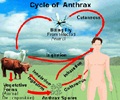Quick response to identify and treat people with inhalation anthrax is needed to minimize the effects of a terrorist attack , however distinguishing
Quick response to identify and treat people with inhalation anthrax is needed to minimize the effects of a terrorist attack , however distinguishing someone who has anthrax from someone who just has the flu, pneumonia or another respiratory-related illness is the question that has remained unanswered.
That’s the question researchers in Chicago set out to answer .They compared 47 cases of anthrax -- including 11 cases blamed on bioterrorism -- with about 375 cases of pneumonia or influenza-like illnesses, looking for differences that might help doctors quickly identify someone as having anthrax rather than a typical lung disease.The analysis pointed to several possibilities: people with anthrax were more likely to have vomiting and nausea, an altered mental state, swollen chest tissue due to enlarged lymph nodes, and a fluid shadow on their chest X-rays. These findings are important, because the release of just one kilogram of anthrax spores could kill more than 100,000 people in a city of 10 million.
Researchers believe these findings represent preliminary efforts toward identifying clinical predictors of inhalational anthrax, but they say more study is needed.






